Business Finance Report: Working Capital, Budgeting and Cashflow
VerifiedAdded on 2023/01/12
|11
|3149
|70
Report
AI Summary
This report delves into the core concepts of business finance, examining the interplay between profit, cash flow, and working capital management. It defines key terms like profit, cash flow, working capital, accounts receivable, inventory, and payables, and analyzes how changes in working capital impact cash flow. The report then applies these concepts to a case study of Mediterranean Delights Ltd, assessing how the company's management practices affect its financial results, including the impact of receivables, payables, and cash flow on working capital. The report also analyzes steps the company should take to improve cash flow through better working capital management. Furthermore, the report explores various budgeting approaches, including traditional, rolling, zero-based, and activity-based budgeting, evaluating their strengths, weaknesses, and suitability for different business contexts. The report also assesses the impact of these budgeting methods on the case study company and provides recommendations on which budgetary system would be most appropriate for the company's future plans.
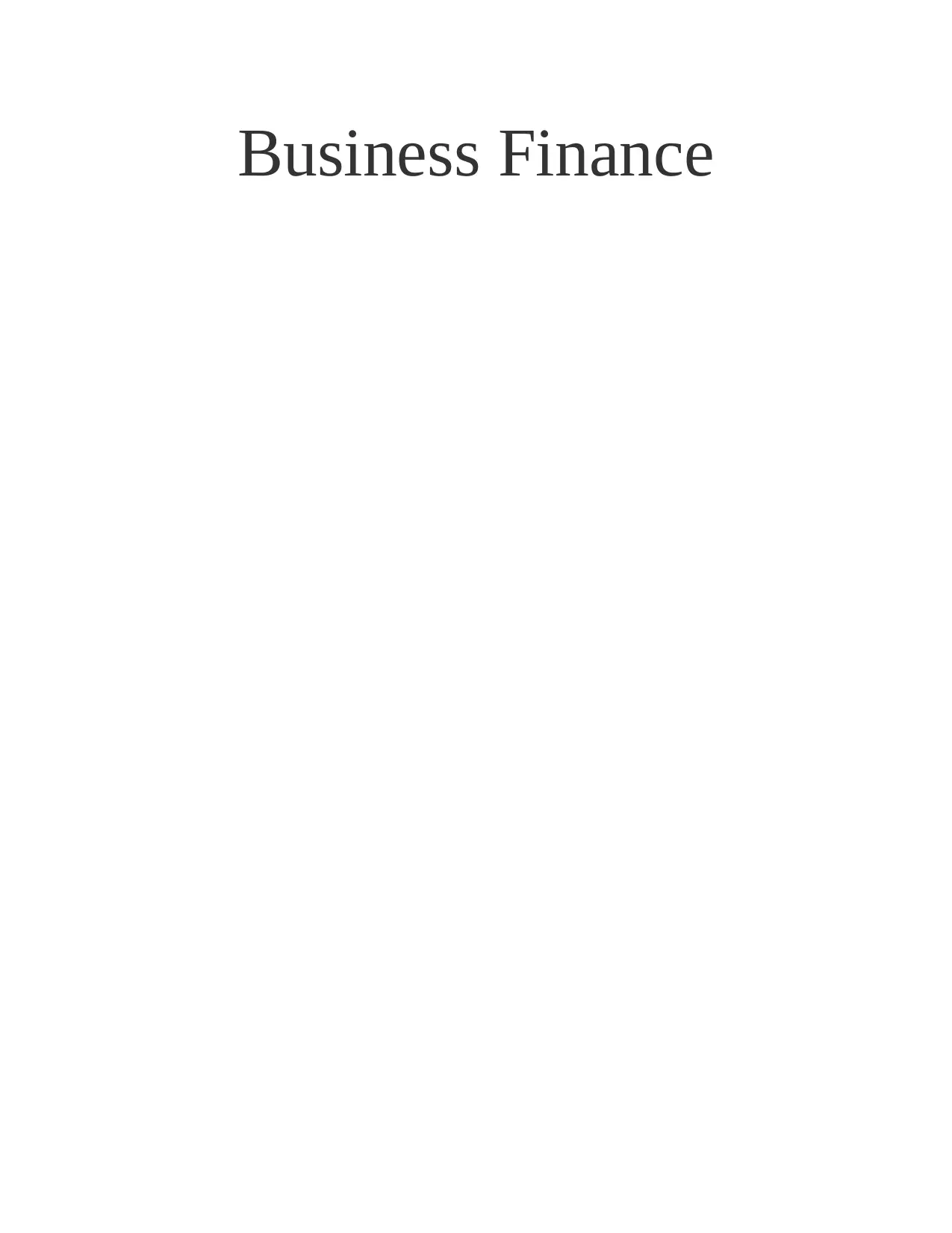
Business Finance
Paraphrase This Document
Need a fresh take? Get an instant paraphrase of this document with our AI Paraphraser
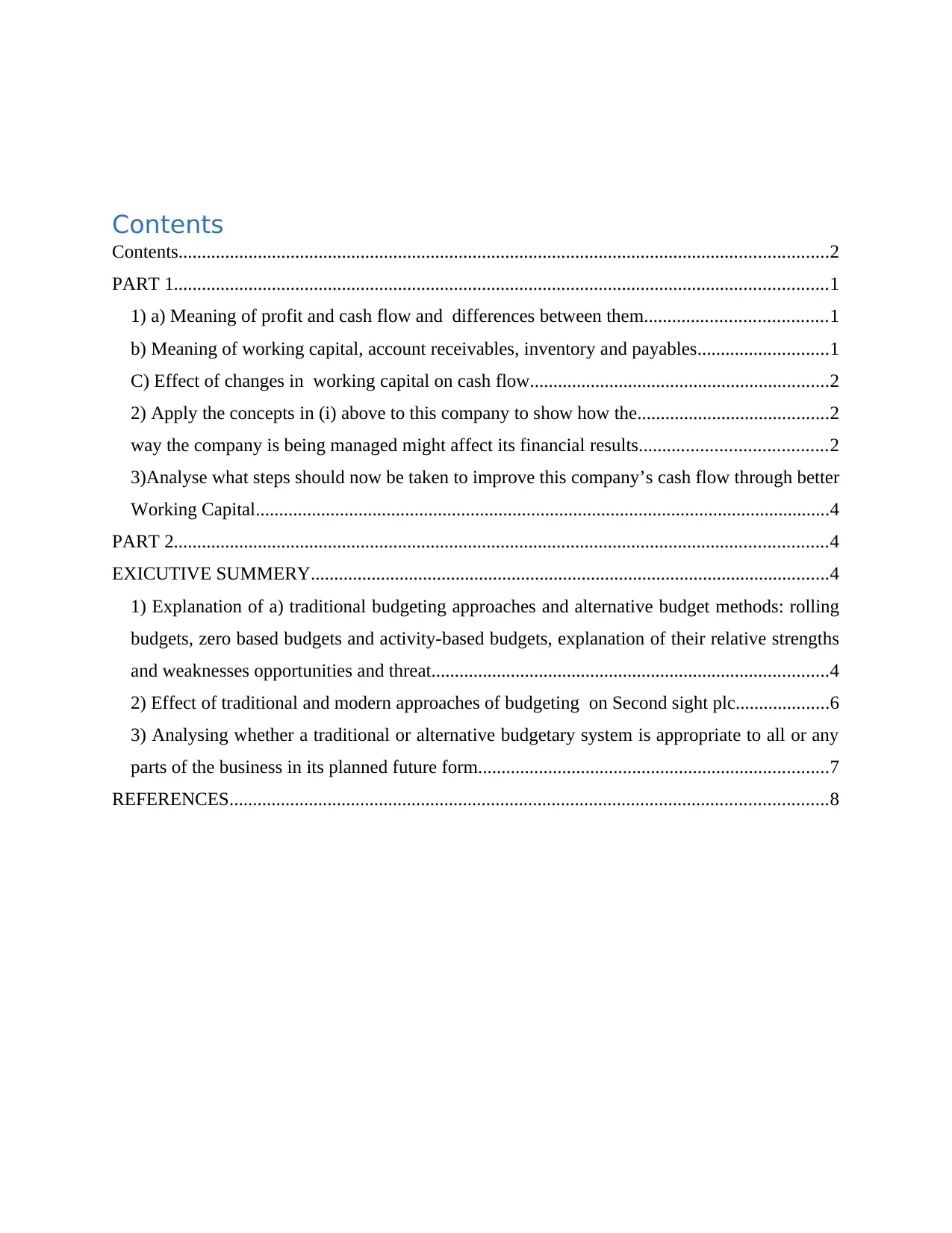
Contents
Contents...........................................................................................................................................2
PART 1............................................................................................................................................1
1) a) Meaning of profit and cash flow and differences between them.......................................1
b) Meaning of working capital, account receivables, inventory and payables............................1
C) Effect of changes in working capital on cash flow................................................................2
2) Apply the concepts in (i) above to this company to show how the.........................................2
way the company is being managed might affect its financial results........................................2
3)Analyse what steps should now be taken to improve this company’s cash flow through better
Working Capital...........................................................................................................................4
PART 2............................................................................................................................................4
EXICUTIVE SUMMERY...............................................................................................................4
1) Explanation of a) traditional budgeting approaches and alternative budget methods: rolling
budgets, zero based budgets and activity-based budgets, explanation of their relative strengths
and weaknesses opportunities and threat.....................................................................................4
2) Effect of traditional and modern approaches of budgeting on Second sight plc....................6
3) Analysing whether a traditional or alternative budgetary system is appropriate to all or any
parts of the business in its planned future form...........................................................................7
REFERENCES................................................................................................................................8
Contents...........................................................................................................................................2
PART 1............................................................................................................................................1
1) a) Meaning of profit and cash flow and differences between them.......................................1
b) Meaning of working capital, account receivables, inventory and payables............................1
C) Effect of changes in working capital on cash flow................................................................2
2) Apply the concepts in (i) above to this company to show how the.........................................2
way the company is being managed might affect its financial results........................................2
3)Analyse what steps should now be taken to improve this company’s cash flow through better
Working Capital...........................................................................................................................4
PART 2............................................................................................................................................4
EXICUTIVE SUMMERY...............................................................................................................4
1) Explanation of a) traditional budgeting approaches and alternative budget methods: rolling
budgets, zero based budgets and activity-based budgets, explanation of their relative strengths
and weaknesses opportunities and threat.....................................................................................4
2) Effect of traditional and modern approaches of budgeting on Second sight plc....................6
3) Analysing whether a traditional or alternative budgetary system is appropriate to all or any
parts of the business in its planned future form...........................................................................7
REFERENCES................................................................................................................................8
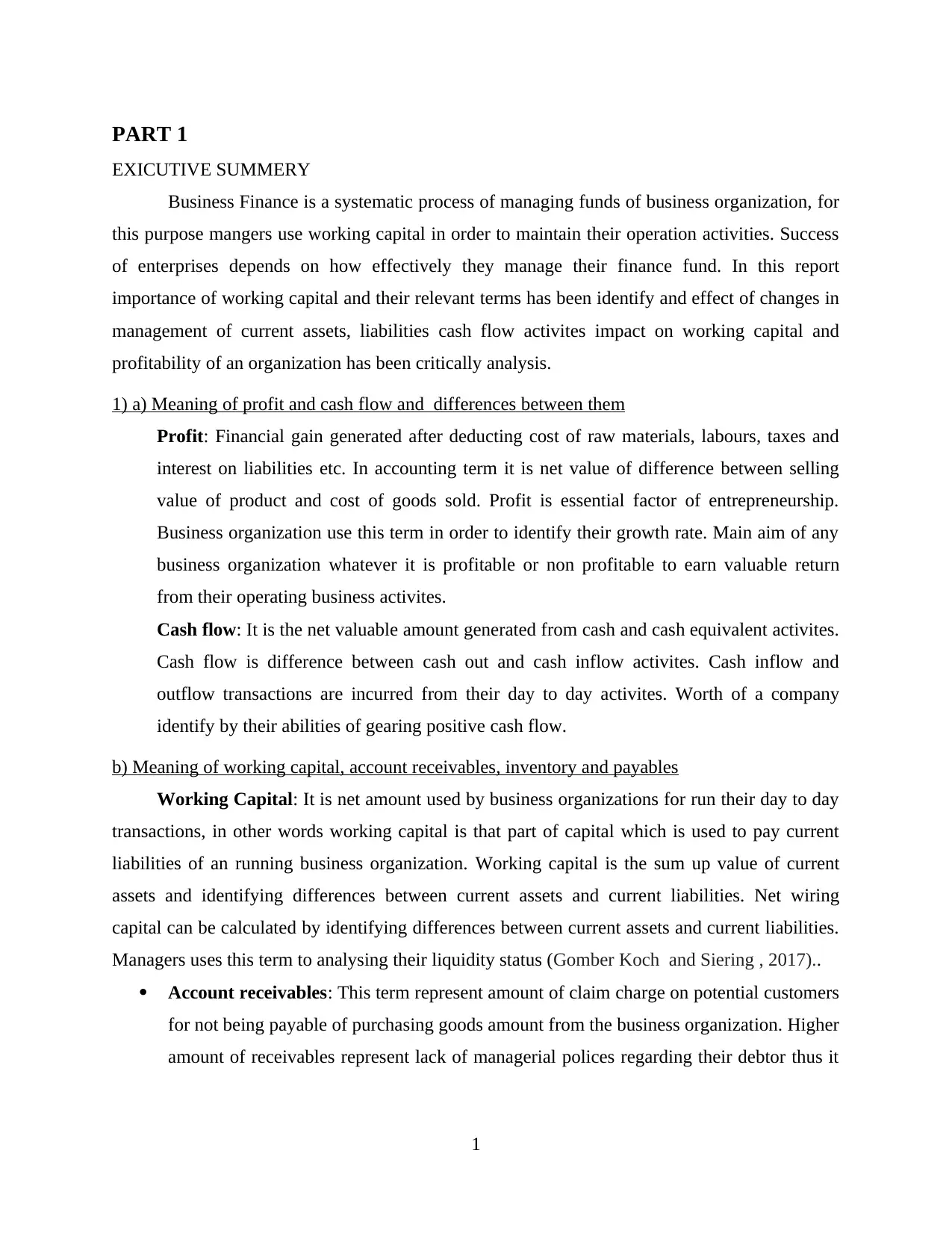
PART 1
EXICUTIVE SUMMERY
Business Finance is a systematic process of managing funds of business organization, for
this purpose mangers use working capital in order to maintain their operation activities. Success
of enterprises depends on how effectively they manage their finance fund. In this report
importance of working capital and their relevant terms has been identify and effect of changes in
management of current assets, liabilities cash flow activites impact on working capital and
profitability of an organization has been critically analysis.
1) a) Meaning of profit and cash flow and differences between them
Profit: Financial gain generated after deducting cost of raw materials, labours, taxes and
interest on liabilities etc. In accounting term it is net value of difference between selling
value of product and cost of goods sold. Profit is essential factor of entrepreneurship.
Business organization use this term in order to identify their growth rate. Main aim of any
business organization whatever it is profitable or non profitable to earn valuable return
from their operating business activites.
Cash flow: It is the net valuable amount generated from cash and cash equivalent activites.
Cash flow is difference between cash out and cash inflow activites. Cash inflow and
outflow transactions are incurred from their day to day activites. Worth of a company
identify by their abilities of gearing positive cash flow.
b) Meaning of working capital, account receivables, inventory and payables
Working Capital: It is net amount used by business organizations for run their day to day
transactions, in other words working capital is that part of capital which is used to pay current
liabilities of an running business organization. Working capital is the sum up value of current
assets and identifying differences between current assets and current liabilities. Net wiring
capital can be calculated by identifying differences between current assets and current liabilities.
Managers uses this term to analysing their liquidity status (Gomber Koch and Siering , 2017)..
Account receivables: This term represent amount of claim charge on potential customers
for not being payable of purchasing goods amount from the business organization. Higher
amount of receivables represent lack of managerial polices regarding their debtor thus it
1
EXICUTIVE SUMMERY
Business Finance is a systematic process of managing funds of business organization, for
this purpose mangers use working capital in order to maintain their operation activities. Success
of enterprises depends on how effectively they manage their finance fund. In this report
importance of working capital and their relevant terms has been identify and effect of changes in
management of current assets, liabilities cash flow activites impact on working capital and
profitability of an organization has been critically analysis.
1) a) Meaning of profit and cash flow and differences between them
Profit: Financial gain generated after deducting cost of raw materials, labours, taxes and
interest on liabilities etc. In accounting term it is net value of difference between selling
value of product and cost of goods sold. Profit is essential factor of entrepreneurship.
Business organization use this term in order to identify their growth rate. Main aim of any
business organization whatever it is profitable or non profitable to earn valuable return
from their operating business activites.
Cash flow: It is the net valuable amount generated from cash and cash equivalent activites.
Cash flow is difference between cash out and cash inflow activites. Cash inflow and
outflow transactions are incurred from their day to day activites. Worth of a company
identify by their abilities of gearing positive cash flow.
b) Meaning of working capital, account receivables, inventory and payables
Working Capital: It is net amount used by business organizations for run their day to day
transactions, in other words working capital is that part of capital which is used to pay current
liabilities of an running business organization. Working capital is the sum up value of current
assets and identifying differences between current assets and current liabilities. Net wiring
capital can be calculated by identifying differences between current assets and current liabilities.
Managers uses this term to analysing their liquidity status (Gomber Koch and Siering , 2017)..
Account receivables: This term represent amount of claim charge on potential customers
for not being payable of purchasing goods amount from the business organization. Higher
amount of receivables represent lack of managerial polices regarding their debtor thus it
1
⊘ This is a preview!⊘
Do you want full access?
Subscribe today to unlock all pages.

Trusted by 1+ million students worldwide
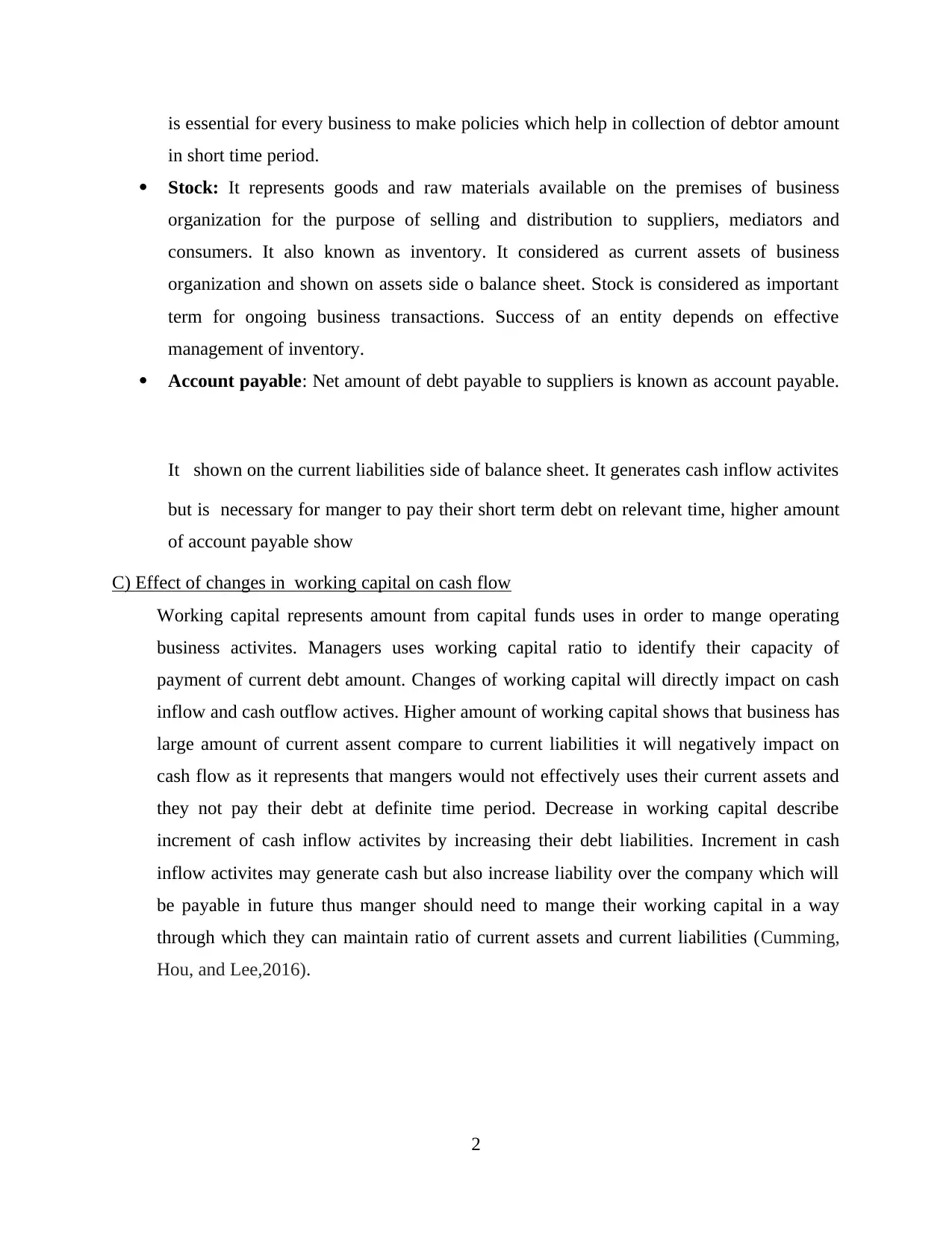
is essential for every business to make policies which help in collection of debtor amount
in short time period.
Stock: It represents goods and raw materials available on the premises of business
organization for the purpose of selling and distribution to suppliers, mediators and
consumers. It also known as inventory. It considered as current assets of business
organization and shown on assets side o balance sheet. Stock is considered as important
term for ongoing business transactions. Success of an entity depends on effective
management of inventory.
Account payable: Net amount of debt payable to suppliers is known as account payable.
It shown on the current liabilities side of balance sheet. It generates cash inflow activites
but is necessary for manger to pay their short term debt on relevant time, higher amount
of account payable show
C) Effect of changes in working capital on cash flow
Working capital represents amount from capital funds uses in order to mange operating
business activites. Managers uses working capital ratio to identify their capacity of
payment of current debt amount. Changes of working capital will directly impact on cash
inflow and cash outflow actives. Higher amount of working capital shows that business has
large amount of current assent compare to current liabilities it will negatively impact on
cash flow as it represents that mangers would not effectively uses their current assets and
they not pay their debt at definite time period. Decrease in working capital describe
increment of cash inflow activites by increasing their debt liabilities. Increment in cash
inflow activites may generate cash but also increase liability over the company which will
be payable in future thus manger should need to mange their working capital in a way
through which they can maintain ratio of current assets and current liabilities (Cumming,
Hou, and Lee,2016).
2
in short time period.
Stock: It represents goods and raw materials available on the premises of business
organization for the purpose of selling and distribution to suppliers, mediators and
consumers. It also known as inventory. It considered as current assets of business
organization and shown on assets side o balance sheet. Stock is considered as important
term for ongoing business transactions. Success of an entity depends on effective
management of inventory.
Account payable: Net amount of debt payable to suppliers is known as account payable.
It shown on the current liabilities side of balance sheet. It generates cash inflow activites
but is necessary for manger to pay their short term debt on relevant time, higher amount
of account payable show
C) Effect of changes in working capital on cash flow
Working capital represents amount from capital funds uses in order to mange operating
business activites. Managers uses working capital ratio to identify their capacity of
payment of current debt amount. Changes of working capital will directly impact on cash
inflow and cash outflow actives. Higher amount of working capital shows that business has
large amount of current assent compare to current liabilities it will negatively impact on
cash flow as it represents that mangers would not effectively uses their current assets and
they not pay their debt at definite time period. Decrease in working capital describe
increment of cash inflow activites by increasing their debt liabilities. Increment in cash
inflow activites may generate cash but also increase liability over the company which will
be payable in future thus manger should need to mange their working capital in a way
through which they can maintain ratio of current assets and current liabilities (Cumming,
Hou, and Lee,2016).
2
Paraphrase This Document
Need a fresh take? Get an instant paraphrase of this document with our AI Paraphraser
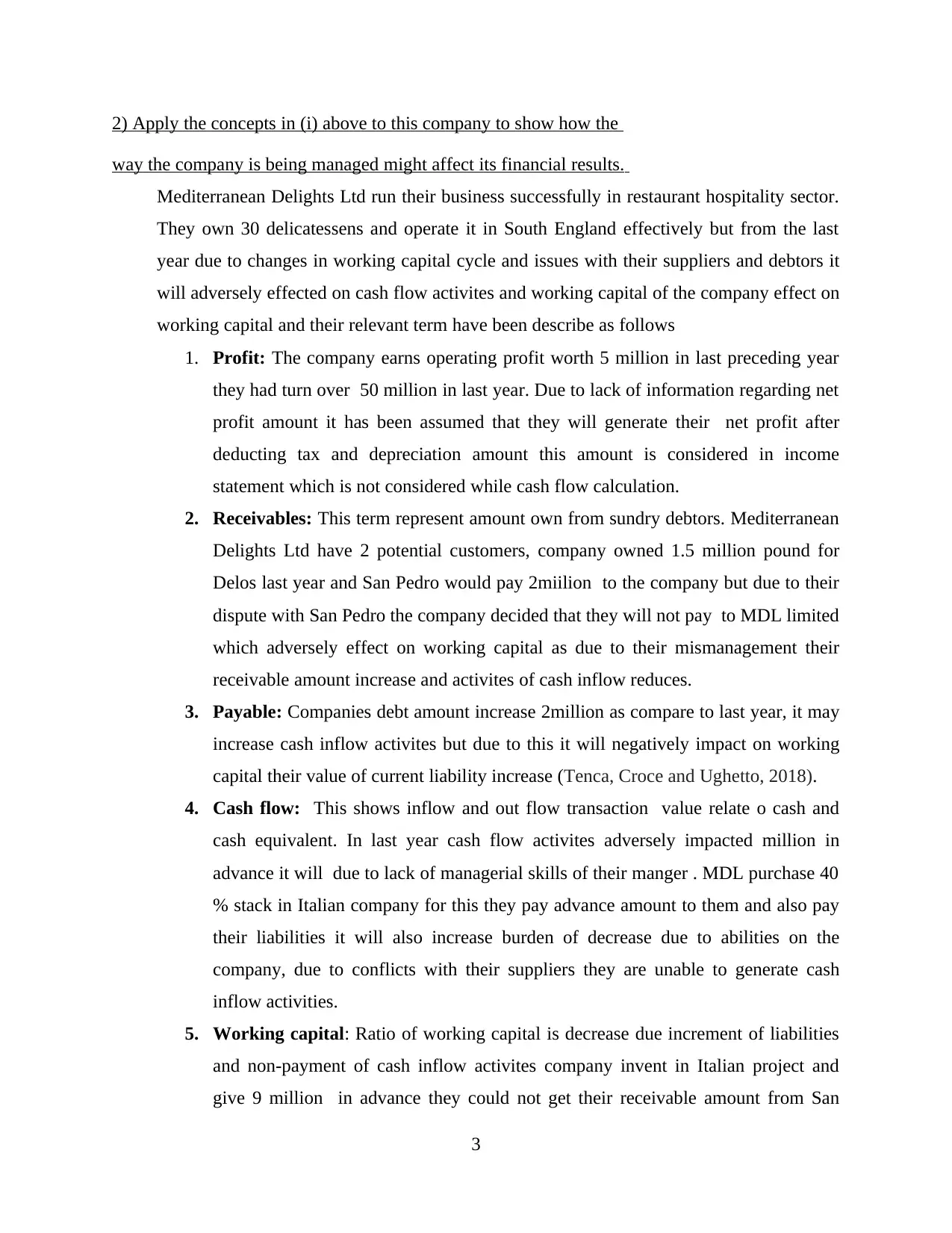
2) Apply the concepts in (i) above to this company to show how the
way the company is being managed might affect its financial results.
Mediterranean Delights Ltd run their business successfully in restaurant hospitality sector.
They own 30 delicatessens and operate it in South England effectively but from the last
year due to changes in working capital cycle and issues with their suppliers and debtors it
will adversely effected on cash flow activites and working capital of the company effect on
working capital and their relevant term have been describe as follows
1. Profit: The company earns operating profit worth 5 million in last preceding year
they had turn over 50 million in last year. Due to lack of information regarding net
profit amount it has been assumed that they will generate their net profit after
deducting tax and depreciation amount this amount is considered in income
statement which is not considered while cash flow calculation.
2. Receivables: This term represent amount own from sundry debtors. Mediterranean
Delights Ltd have 2 potential customers, company owned 1.5 million pound for
Delos last year and San Pedro would pay 2miilion to the company but due to their
dispute with San Pedro the company decided that they will not pay to MDL limited
which adversely effect on working capital as due to their mismanagement their
receivable amount increase and activites of cash inflow reduces.
3. Payable: Companies debt amount increase 2million as compare to last year, it may
increase cash inflow activites but due to this it will negatively impact on working
capital their value of current liability increase (Tenca, Croce and Ughetto, 2018).
4. Cash flow: This shows inflow and out flow transaction value relate o cash and
cash equivalent. In last year cash flow activites adversely impacted million in
advance it will due to lack of managerial skills of their manger . MDL purchase 40
% stack in Italian company for this they pay advance amount to them and also pay
their liabilities it will also increase burden of decrease due to abilities on the
company, due to conflicts with their suppliers they are unable to generate cash
inflow activities.
5. Working capital: Ratio of working capital is decrease due increment of liabilities
and non-payment of cash inflow activites company invent in Italian project and
give 9 million in advance they could not get their receivable amount from San
3
way the company is being managed might affect its financial results.
Mediterranean Delights Ltd run their business successfully in restaurant hospitality sector.
They own 30 delicatessens and operate it in South England effectively but from the last
year due to changes in working capital cycle and issues with their suppliers and debtors it
will adversely effected on cash flow activites and working capital of the company effect on
working capital and their relevant term have been describe as follows
1. Profit: The company earns operating profit worth 5 million in last preceding year
they had turn over 50 million in last year. Due to lack of information regarding net
profit amount it has been assumed that they will generate their net profit after
deducting tax and depreciation amount this amount is considered in income
statement which is not considered while cash flow calculation.
2. Receivables: This term represent amount own from sundry debtors. Mediterranean
Delights Ltd have 2 potential customers, company owned 1.5 million pound for
Delos last year and San Pedro would pay 2miilion to the company but due to their
dispute with San Pedro the company decided that they will not pay to MDL limited
which adversely effect on working capital as due to their mismanagement their
receivable amount increase and activites of cash inflow reduces.
3. Payable: Companies debt amount increase 2million as compare to last year, it may
increase cash inflow activites but due to this it will negatively impact on working
capital their value of current liability increase (Tenca, Croce and Ughetto, 2018).
4. Cash flow: This shows inflow and out flow transaction value relate o cash and
cash equivalent. In last year cash flow activites adversely impacted million in
advance it will due to lack of managerial skills of their manger . MDL purchase 40
% stack in Italian company for this they pay advance amount to them and also pay
their liabilities it will also increase burden of decrease due to abilities on the
company, due to conflicts with their suppliers they are unable to generate cash
inflow activities.
5. Working capital: Ratio of working capital is decrease due increment of liabilities
and non-payment of cash inflow activites company invent in Italian project and
give 9 million in advance they could not get their receivable amount from San
3
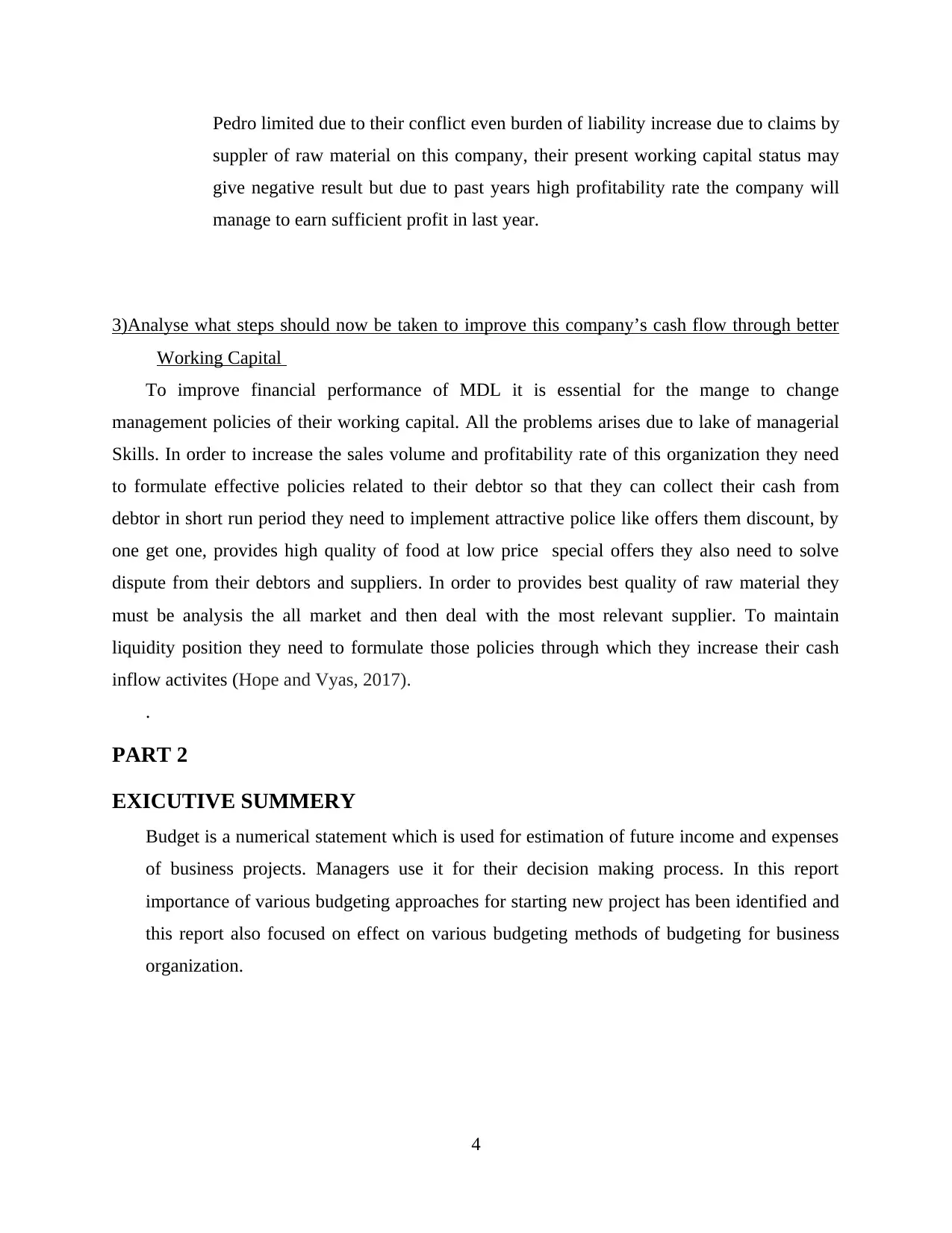
Pedro limited due to their conflict even burden of liability increase due to claims by
suppler of raw material on this company, their present working capital status may
give negative result but due to past years high profitability rate the company will
manage to earn sufficient profit in last year.
3)Analyse what steps should now be taken to improve this company’s cash flow through better
Working Capital
To improve financial performance of MDL it is essential for the mange to change
management policies of their working capital. All the problems arises due to lake of managerial
Skills. In order to increase the sales volume and profitability rate of this organization they need
to formulate effective policies related to their debtor so that they can collect their cash from
debtor in short run period they need to implement attractive police like offers them discount, by
one get one, provides high quality of food at low price special offers they also need to solve
dispute from their debtors and suppliers. In order to provides best quality of raw material they
must be analysis the all market and then deal with the most relevant supplier. To maintain
liquidity position they need to formulate those policies through which they increase their cash
inflow activites (Hope and Vyas, 2017).
.
PART 2
EXICUTIVE SUMMERY
Budget is a numerical statement which is used for estimation of future income and expenses
of business projects. Managers use it for their decision making process. In this report
importance of various budgeting approaches for starting new project has been identified and
this report also focused on effect on various budgeting methods of budgeting for business
organization.
4
suppler of raw material on this company, their present working capital status may
give negative result but due to past years high profitability rate the company will
manage to earn sufficient profit in last year.
3)Analyse what steps should now be taken to improve this company’s cash flow through better
Working Capital
To improve financial performance of MDL it is essential for the mange to change
management policies of their working capital. All the problems arises due to lake of managerial
Skills. In order to increase the sales volume and profitability rate of this organization they need
to formulate effective policies related to their debtor so that they can collect their cash from
debtor in short run period they need to implement attractive police like offers them discount, by
one get one, provides high quality of food at low price special offers they also need to solve
dispute from their debtors and suppliers. In order to provides best quality of raw material they
must be analysis the all market and then deal with the most relevant supplier. To maintain
liquidity position they need to formulate those policies through which they increase their cash
inflow activites (Hope and Vyas, 2017).
.
PART 2
EXICUTIVE SUMMERY
Budget is a numerical statement which is used for estimation of future income and expenses
of business projects. Managers use it for their decision making process. In this report
importance of various budgeting approaches for starting new project has been identified and
this report also focused on effect on various budgeting methods of budgeting for business
organization.
4
⊘ This is a preview!⊘
Do you want full access?
Subscribe today to unlock all pages.

Trusted by 1+ million students worldwide
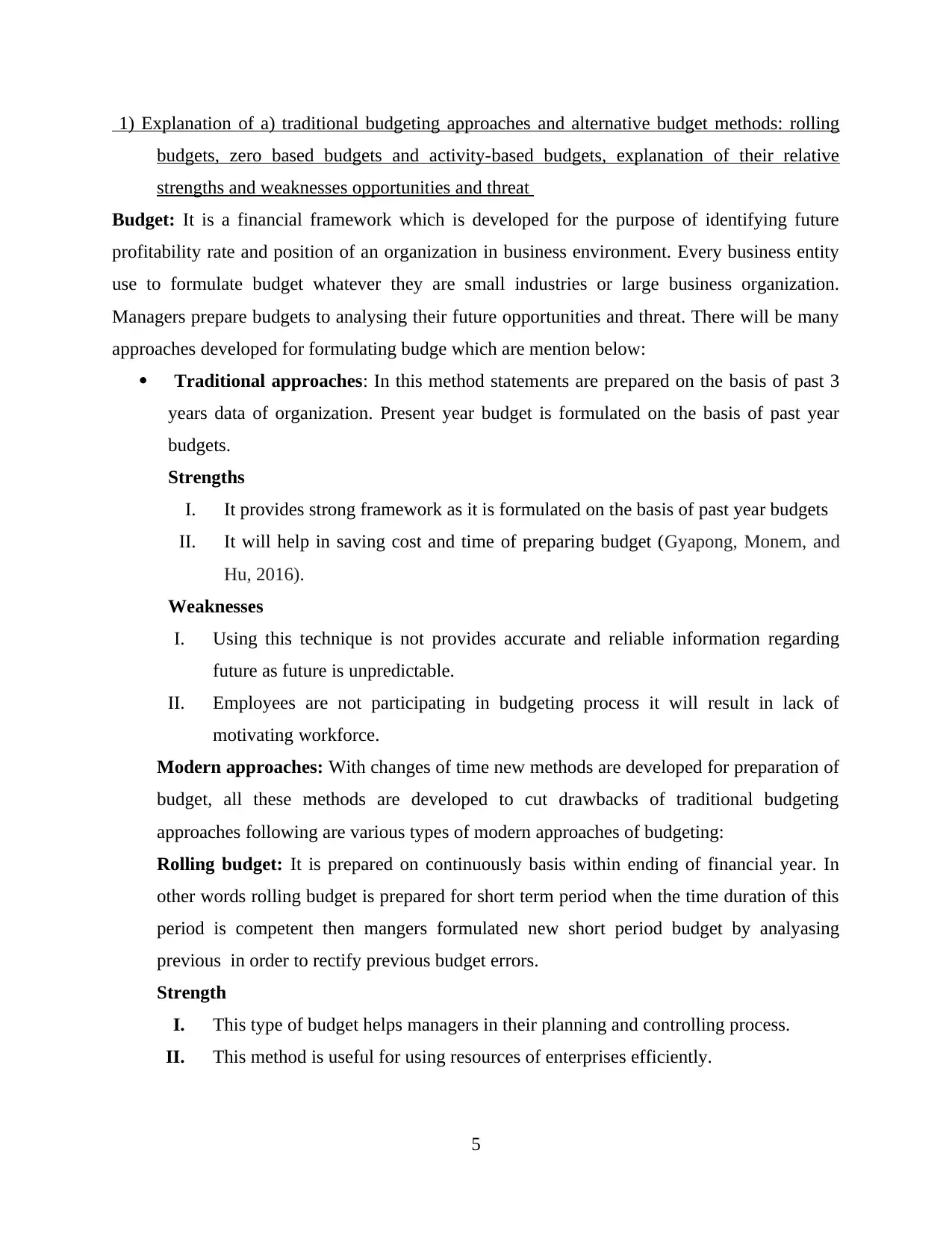
1) Explanation of a) traditional budgeting approaches and alternative budget methods: rolling
budgets, zero based budgets and activity-based budgets, explanation of their relative
strengths and weaknesses opportunities and threat
Budget: It is a financial framework which is developed for the purpose of identifying future
profitability rate and position of an organization in business environment. Every business entity
use to formulate budget whatever they are small industries or large business organization.
Managers prepare budgets to analysing their future opportunities and threat. There will be many
approaches developed for formulating budge which are mention below:
Traditional approaches: In this method statements are prepared on the basis of past 3
years data of organization. Present year budget is formulated on the basis of past year
budgets.
Strengths
I. It provides strong framework as it is formulated on the basis of past year budgets
II. It will help in saving cost and time of preparing budget (Gyapong, Monem, and
Hu, 2016).
Weaknesses
I. Using this technique is not provides accurate and reliable information regarding
future as future is unpredictable.
II. Employees are not participating in budgeting process it will result in lack of
motivating workforce.
Modern approaches: With changes of time new methods are developed for preparation of
budget, all these methods are developed to cut drawbacks of traditional budgeting
approaches following are various types of modern approaches of budgeting:
Rolling budget: It is prepared on continuously basis within ending of financial year. In
other words rolling budget is prepared for short term period when the time duration of this
period is competent then mangers formulated new short period budget by analyasing
previous in order to rectify previous budget errors.
Strength
I. This type of budget helps managers in their planning and controlling process.
II. This method is useful for using resources of enterprises efficiently.
5
budgets, zero based budgets and activity-based budgets, explanation of their relative
strengths and weaknesses opportunities and threat
Budget: It is a financial framework which is developed for the purpose of identifying future
profitability rate and position of an organization in business environment. Every business entity
use to formulate budget whatever they are small industries or large business organization.
Managers prepare budgets to analysing their future opportunities and threat. There will be many
approaches developed for formulating budge which are mention below:
Traditional approaches: In this method statements are prepared on the basis of past 3
years data of organization. Present year budget is formulated on the basis of past year
budgets.
Strengths
I. It provides strong framework as it is formulated on the basis of past year budgets
II. It will help in saving cost and time of preparing budget (Gyapong, Monem, and
Hu, 2016).
Weaknesses
I. Using this technique is not provides accurate and reliable information regarding
future as future is unpredictable.
II. Employees are not participating in budgeting process it will result in lack of
motivating workforce.
Modern approaches: With changes of time new methods are developed for preparation of
budget, all these methods are developed to cut drawbacks of traditional budgeting
approaches following are various types of modern approaches of budgeting:
Rolling budget: It is prepared on continuously basis within ending of financial year. In
other words rolling budget is prepared for short term period when the time duration of this
period is competent then mangers formulated new short period budget by analyasing
previous in order to rectify previous budget errors.
Strength
I. This type of budget helps managers in their planning and controlling process.
II. This method is useful for using resources of enterprises efficiently.
5
Paraphrase This Document
Need a fresh take? Get an instant paraphrase of this document with our AI Paraphraser
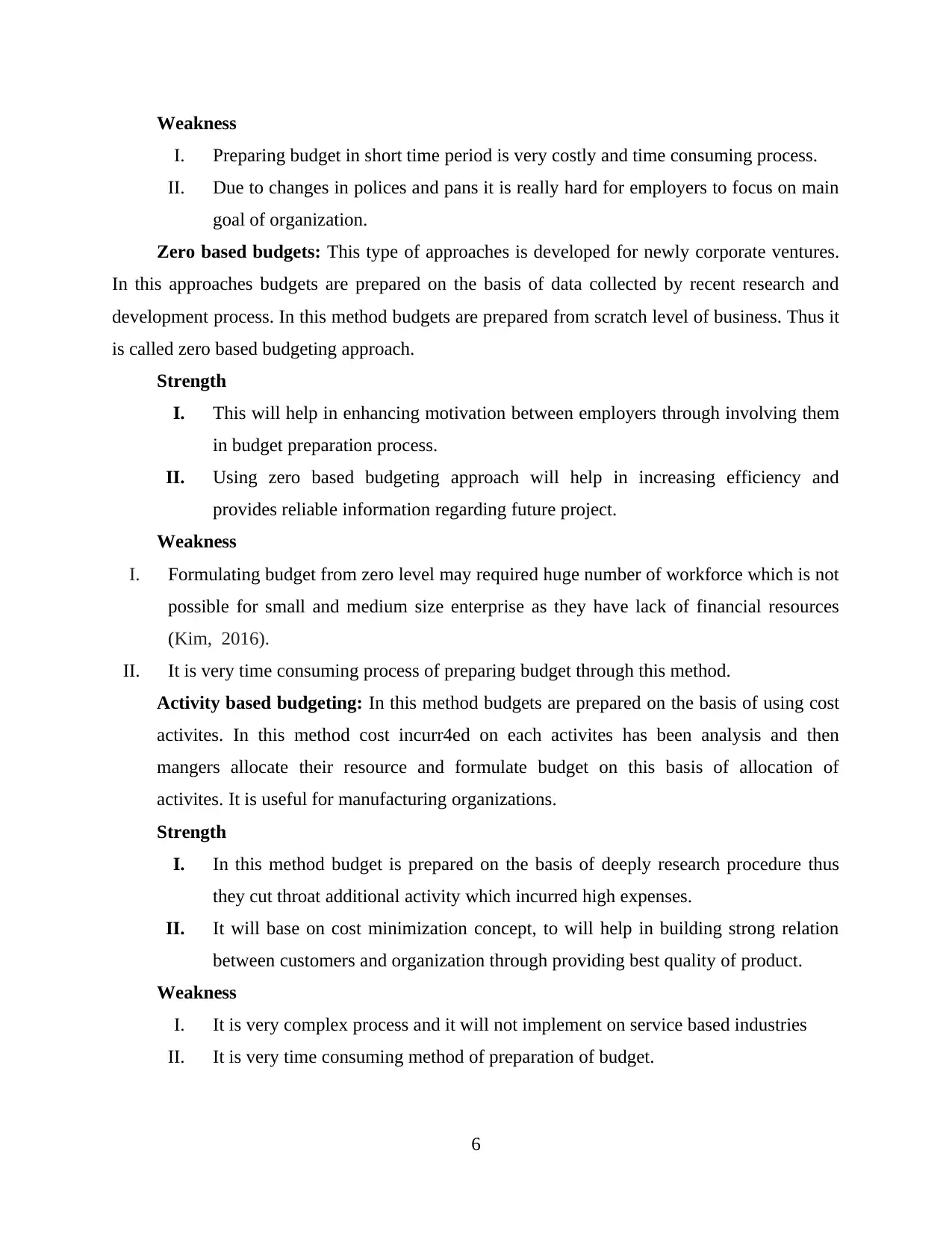
Weakness
I. Preparing budget in short time period is very costly and time consuming process.
II. Due to changes in polices and pans it is really hard for employers to focus on main
goal of organization.
Zero based budgets: This type of approaches is developed for newly corporate ventures.
In this approaches budgets are prepared on the basis of data collected by recent research and
development process. In this method budgets are prepared from scratch level of business. Thus it
is called zero based budgeting approach.
Strength
I. This will help in enhancing motivation between employers through involving them
in budget preparation process.
II. Using zero based budgeting approach will help in increasing efficiency and
provides reliable information regarding future project.
Weakness
I. Formulating budget from zero level may required huge number of workforce which is not
possible for small and medium size enterprise as they have lack of financial resources
(Kim, 2016).
II. It is very time consuming process of preparing budget through this method.
Activity based budgeting: In this method budgets are prepared on the basis of using cost
activites. In this method cost incurr4ed on each activites has been analysis and then
mangers allocate their resource and formulate budget on this basis of allocation of
activites. It is useful for manufacturing organizations.
Strength
I. In this method budget is prepared on the basis of deeply research procedure thus
they cut throat additional activity which incurred high expenses.
II. It will base on cost minimization concept, to will help in building strong relation
between customers and organization through providing best quality of product.
Weakness
I. It is very complex process and it will not implement on service based industries
II. It is very time consuming method of preparation of budget.
6
I. Preparing budget in short time period is very costly and time consuming process.
II. Due to changes in polices and pans it is really hard for employers to focus on main
goal of organization.
Zero based budgets: This type of approaches is developed for newly corporate ventures.
In this approaches budgets are prepared on the basis of data collected by recent research and
development process. In this method budgets are prepared from scratch level of business. Thus it
is called zero based budgeting approach.
Strength
I. This will help in enhancing motivation between employers through involving them
in budget preparation process.
II. Using zero based budgeting approach will help in increasing efficiency and
provides reliable information regarding future project.
Weakness
I. Formulating budget from zero level may required huge number of workforce which is not
possible for small and medium size enterprise as they have lack of financial resources
(Kim, 2016).
II. It is very time consuming process of preparing budget through this method.
Activity based budgeting: In this method budgets are prepared on the basis of using cost
activites. In this method cost incurr4ed on each activites has been analysis and then
mangers allocate their resource and formulate budget on this basis of allocation of
activites. It is useful for manufacturing organizations.
Strength
I. In this method budget is prepared on the basis of deeply research procedure thus
they cut throat additional activity which incurred high expenses.
II. It will base on cost minimization concept, to will help in building strong relation
between customers and organization through providing best quality of product.
Weakness
I. It is very complex process and it will not implement on service based industries
II. It is very time consuming method of preparation of budget.
6
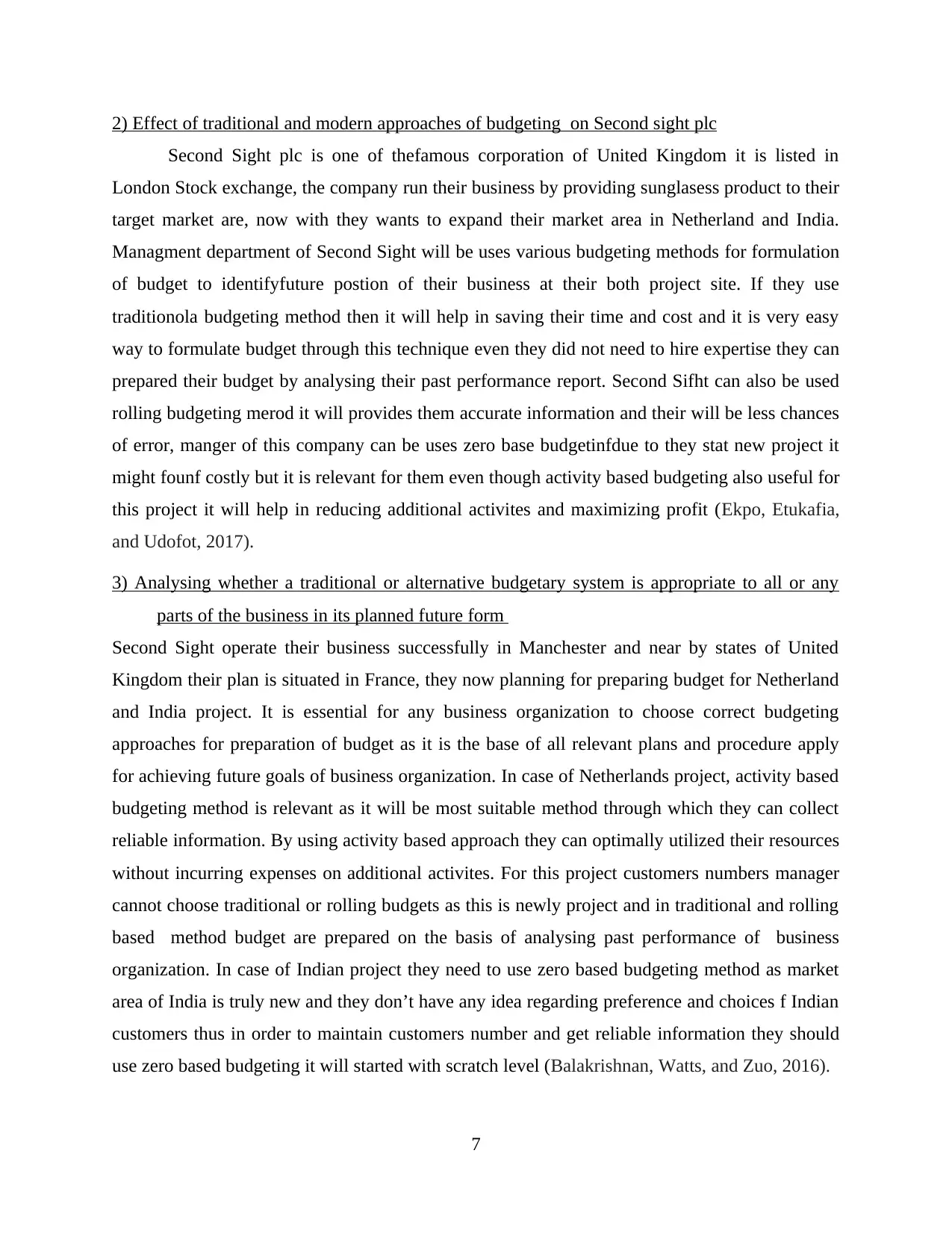
2) Effect of traditional and modern approaches of budgeting on Second sight plc
Second Sight plc is one of thefamous corporation of United Kingdom it is listed in
London Stock exchange, the company run their business by providing sunglasess product to their
target market are, now with they wants to expand their market area in Netherland and India.
Managment department of Second Sight will be uses various budgeting methods for formulation
of budget to identifyfuture postion of their business at their both project site. If they use
traditionola budgeting method then it will help in saving their time and cost and it is very easy
way to formulate budget through this technique even they did not need to hire expertise they can
prepared their budget by analysing their past performance report. Second Sifht can also be used
rolling budgeting merod it will provides them accurate information and their will be less chances
of error, manger of this company can be uses zero base budgetinfdue to they stat new project it
might founf costly but it is relevant for them even though activity based budgeting also useful for
this project it will help in reducing additional activites and maximizing profit (Ekpo, Etukafia,
and Udofot, 2017).
3) Analysing whether a traditional or alternative budgetary system is appropriate to all or any
parts of the business in its planned future form
Second Sight operate their business successfully in Manchester and near by states of United
Kingdom their plan is situated in France, they now planning for preparing budget for Netherland
and India project. It is essential for any business organization to choose correct budgeting
approaches for preparation of budget as it is the base of all relevant plans and procedure apply
for achieving future goals of business organization. In case of Netherlands project, activity based
budgeting method is relevant as it will be most suitable method through which they can collect
reliable information. By using activity based approach they can optimally utilized their resources
without incurring expenses on additional activites. For this project customers numbers manager
cannot choose traditional or rolling budgets as this is newly project and in traditional and rolling
based method budget are prepared on the basis of analysing past performance of business
organization. In case of Indian project they need to use zero based budgeting method as market
area of India is truly new and they don’t have any idea regarding preference and choices f Indian
customers thus in order to maintain customers number and get reliable information they should
use zero based budgeting it will started with scratch level (Balakrishnan, Watts, and Zuo, 2016).
7
Second Sight plc is one of thefamous corporation of United Kingdom it is listed in
London Stock exchange, the company run their business by providing sunglasess product to their
target market are, now with they wants to expand their market area in Netherland and India.
Managment department of Second Sight will be uses various budgeting methods for formulation
of budget to identifyfuture postion of their business at their both project site. If they use
traditionola budgeting method then it will help in saving their time and cost and it is very easy
way to formulate budget through this technique even they did not need to hire expertise they can
prepared their budget by analysing their past performance report. Second Sifht can also be used
rolling budgeting merod it will provides them accurate information and their will be less chances
of error, manger of this company can be uses zero base budgetinfdue to they stat new project it
might founf costly but it is relevant for them even though activity based budgeting also useful for
this project it will help in reducing additional activites and maximizing profit (Ekpo, Etukafia,
and Udofot, 2017).
3) Analysing whether a traditional or alternative budgetary system is appropriate to all or any
parts of the business in its planned future form
Second Sight operate their business successfully in Manchester and near by states of United
Kingdom their plan is situated in France, they now planning for preparing budget for Netherland
and India project. It is essential for any business organization to choose correct budgeting
approaches for preparation of budget as it is the base of all relevant plans and procedure apply
for achieving future goals of business organization. In case of Netherlands project, activity based
budgeting method is relevant as it will be most suitable method through which they can collect
reliable information. By using activity based approach they can optimally utilized their resources
without incurring expenses on additional activites. For this project customers numbers manager
cannot choose traditional or rolling budgets as this is newly project and in traditional and rolling
based method budget are prepared on the basis of analysing past performance of business
organization. In case of Indian project they need to use zero based budgeting method as market
area of India is truly new and they don’t have any idea regarding preference and choices f Indian
customers thus in order to maintain customers number and get reliable information they should
use zero based budgeting it will started with scratch level (Balakrishnan, Watts, and Zuo, 2016).
7
⊘ This is a preview!⊘
Do you want full access?
Subscribe today to unlock all pages.

Trusted by 1+ million students worldwide
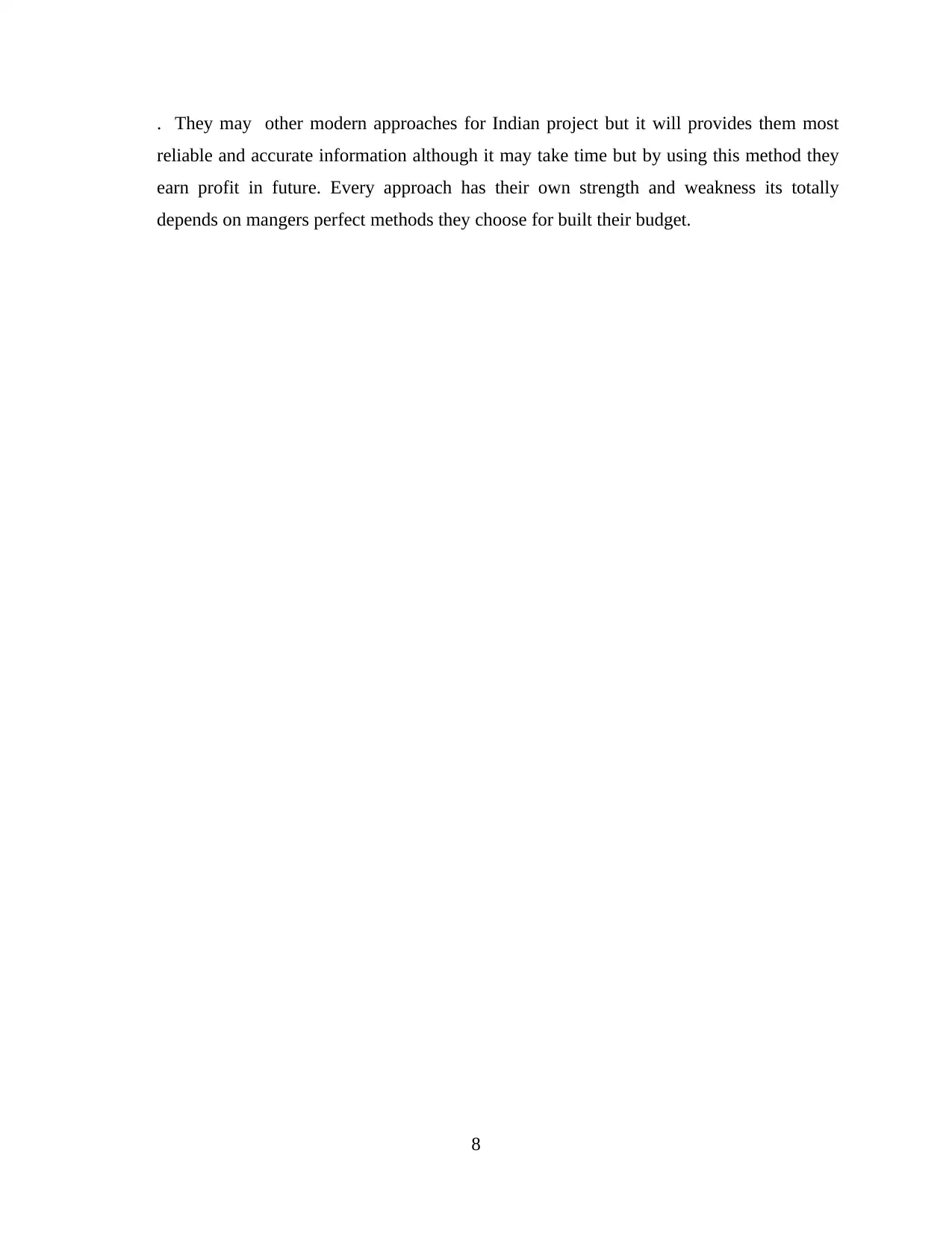
. They may other modern approaches for Indian project but it will provides them most
reliable and accurate information although it may take time but by using this method they
earn profit in future. Every approach has their own strength and weakness its totally
depends on mangers perfect methods they choose for built their budget.
8
reliable and accurate information although it may take time but by using this method they
earn profit in future. Every approach has their own strength and weakness its totally
depends on mangers perfect methods they choose for built their budget.
8
Paraphrase This Document
Need a fresh take? Get an instant paraphrase of this document with our AI Paraphraser
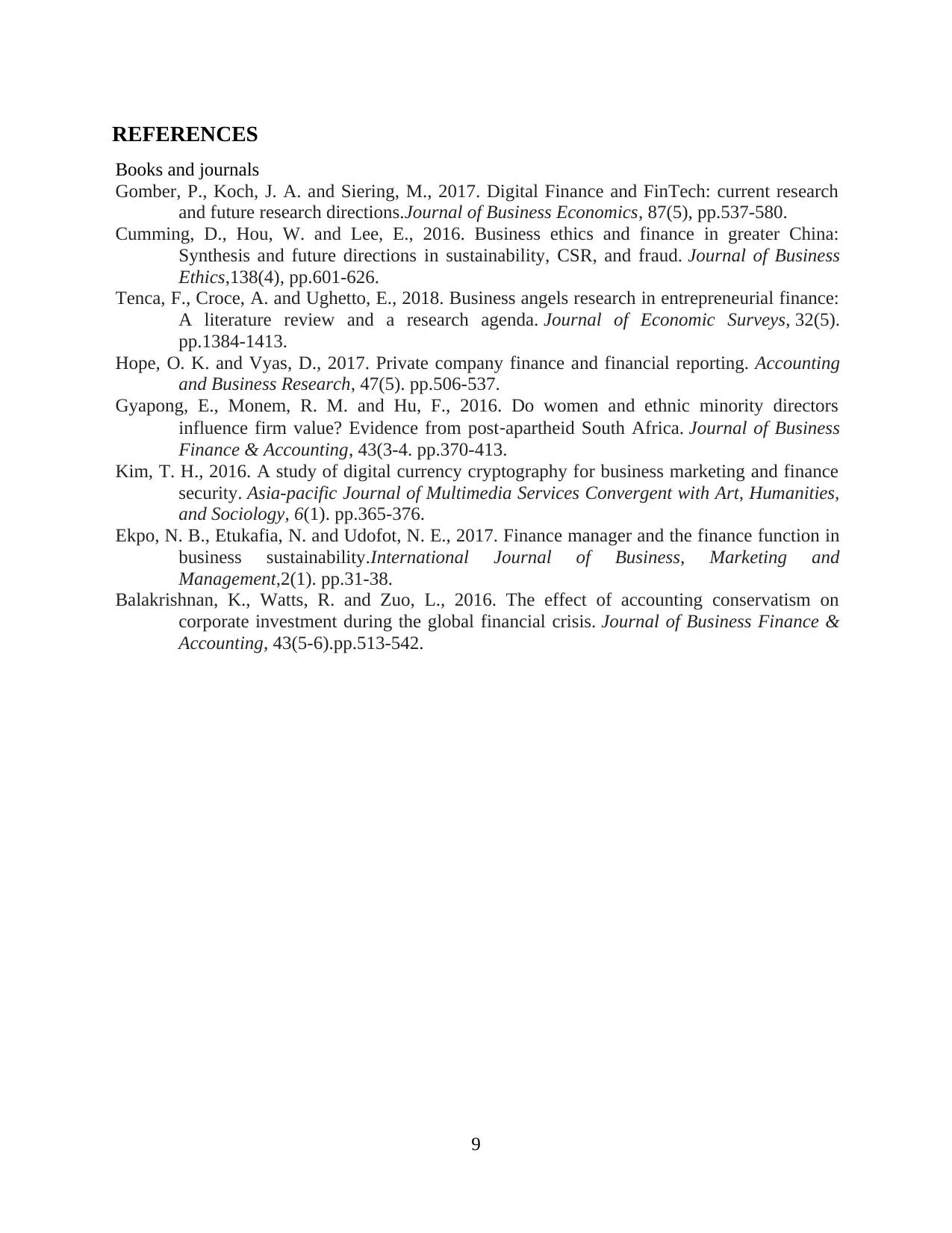
REFERENCES
Books and journals
Gomber, P., Koch, J. A. and Siering, M., 2017. Digital Finance and FinTech: current research
and future research directions.Journal of Business Economics, 87(5), pp.537-580.
Cumming, D., Hou, W. and Lee, E., 2016. Business ethics and finance in greater China:
Synthesis and future directions in sustainability, CSR, and fraud. Journal of Business
Ethics,138(4), pp.601-626.
Tenca, F., Croce, A. and Ughetto, E., 2018. Business angels research in entrepreneurial finance:
A literature review and a research agenda. Journal of Economic Surveys, 32(5).
pp.1384-1413.
Hope, O. K. and Vyas, D., 2017. Private company finance and financial reporting. Accounting
and Business Research, 47(5). pp.506-537.
Gyapong, E., Monem, R. M. and Hu, F., 2016. Do women and ethnic minority directors
influence firm value? Evidence from post‐apartheid South Africa. Journal of Business
Finance & Accounting, 43(3-4. pp.370-413.
Kim, T. H., 2016. A study of digital currency cryptography for business marketing and finance
security. Asia-pacific Journal of Multimedia Services Convergent with Art, Humanities,
and Sociology, 6(1). pp.365-376.
Ekpo, N. B., Etukafia, N. and Udofot, N. E., 2017. Finance manager and the finance function in
business sustainability.International Journal of Business, Marketing and
Management,2(1). pp.31-38.
Balakrishnan, K., Watts, R. and Zuo, L., 2016. The effect of accounting conservatism on
corporate investment during the global financial crisis. Journal of Business Finance &
Accounting, 43(5-6).pp.513-542.
9
Books and journals
Gomber, P., Koch, J. A. and Siering, M., 2017. Digital Finance and FinTech: current research
and future research directions.Journal of Business Economics, 87(5), pp.537-580.
Cumming, D., Hou, W. and Lee, E., 2016. Business ethics and finance in greater China:
Synthesis and future directions in sustainability, CSR, and fraud. Journal of Business
Ethics,138(4), pp.601-626.
Tenca, F., Croce, A. and Ughetto, E., 2018. Business angels research in entrepreneurial finance:
A literature review and a research agenda. Journal of Economic Surveys, 32(5).
pp.1384-1413.
Hope, O. K. and Vyas, D., 2017. Private company finance and financial reporting. Accounting
and Business Research, 47(5). pp.506-537.
Gyapong, E., Monem, R. M. and Hu, F., 2016. Do women and ethnic minority directors
influence firm value? Evidence from post‐apartheid South Africa. Journal of Business
Finance & Accounting, 43(3-4. pp.370-413.
Kim, T. H., 2016. A study of digital currency cryptography for business marketing and finance
security. Asia-pacific Journal of Multimedia Services Convergent with Art, Humanities,
and Sociology, 6(1). pp.365-376.
Ekpo, N. B., Etukafia, N. and Udofot, N. E., 2017. Finance manager and the finance function in
business sustainability.International Journal of Business, Marketing and
Management,2(1). pp.31-38.
Balakrishnan, K., Watts, R. and Zuo, L., 2016. The effect of accounting conservatism on
corporate investment during the global financial crisis. Journal of Business Finance &
Accounting, 43(5-6).pp.513-542.
9
1 out of 11
Related Documents
Your All-in-One AI-Powered Toolkit for Academic Success.
+13062052269
info@desklib.com
Available 24*7 on WhatsApp / Email
![[object Object]](/_next/static/media/star-bottom.7253800d.svg)
Unlock your academic potential
Copyright © 2020–2025 A2Z Services. All Rights Reserved. Developed and managed by ZUCOL.





